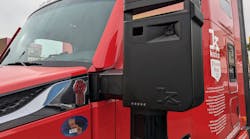CES 2024: The future is almost here for latest truck technology
LAS VEGAS—More trucks and trucking technology might be displayed here at the Consumer Electronic Show than ever before. While trucking is still a small subset of the thousands of exhibitors who’ve descended upon this desert oasis, you can’t miss the growing commercial vehicle presence here.
With a big focus on autonomous driving, Kodiak Robotics, Aurora Innovation, Torc Robotics, and Gatik AI all came to CES 2024, along with up to 300,000 attendees, to show off new developments and partnerships at the Las Vegas Convention Center and up and down the Vegas Strip.
A lot of these companies’ technologies appeared more theoretical years ago. But the future is almost here, according to the people behind some of the most innovative freight equipment ever seen.
FleetOwner started covering CES in 2018 when Paccar debuted at what has become the largest annual technology gathering in North America. This year, the sprawling conference and exhibition is full of commercial vehicles of all sizes—from startups to longstanding OEMs. Paccar’s booth this year features its Peterbilt Super Truck II and its Class 8 hydrogen fuel cell truck that is nearing production.
See also: Bosch doubles down on hydrogen as key to trucking’s sustainable future
Nikola, the first company in the North American market with a Class 8 hydrogen fuel cell truck, is using CES to give consumers, analysts, and investors a chance to climb into the zero-emission cabover tractor for rides around the city.
Here are some news, equipment, and technology that caught our eye during the first couple of days of CES 2024.
Kodiak says its tech is ready for driverless trucking
Kodiak Robotics used CES to show off its driverless-ready Class 8 truck, designed for scaled deployment beginning this year. The road-ready Kodiak truck has redundant safety-critical hardware the company said is needed to scale up commercial driverless operations.
The truck uses Kodiak’s sixth generation of AV technology, developed over the past five years. During that time, Kodiak’s real-world testing included 5,000 loads hauled more than 2.5 million miles on U.S. highways. This new truck technology will be used for Kodiak’s driverless operations, which it plans to initiate between Dallas and Houston later this year.
See also: The humanless difference: Autonomous efficiency goes beyond fuel savings
The latest Kodiak truck includes redundancy across all safety-critical functions, including a redundant braking system, redundant steering, redundant power, and Kodiak’s custom-designed high-integrity actuation control engine system.
While some of its rivals are partnering with truck OEMs to develop autonomous driving, the Kodiak Driver is vehicle-agnostic and designed for upfitting. Kodiak plans to roll out its sixth-generation truck to multiple vehicle types.
The latest Kodiak truck features twice the GPU processor cores, 1.6x greater processing speed, 3x more memory, and 2.75x greater bandwidth to run software processes than Kodiak’s first-generation truck. With this launch, Kodiak’s driverless truck design is now feature-complete across both hardware and software, according to company leaders.
Aurora turns to Continental for AV system production
Continental and Aurora Innovation showed off this Peterbilt 579 equipped with Aurora’s self-driving truck technology. The companies recently finalized the design and architecture of the future fallback system and hardware of the Aurora Driver, a Level 4 autonomous driving system that Continental plans to start producing in 2027. The finalized hardware design comes less than a year after the companies began their partnership to develop high-volume manufacturing of autonomous trucking systems.
Aurora is also working with Continental’s engineering team to update its industrialized fallback system for 2027 production. Autonomous vehicles need built-in redundancies that provide backups in the rare case a component or sensor fails. One of these redundancies is the fallback system, a specialized secondary computer that can take over operation if a failure occurs in the primary system. This dual engineering approach aims to reduce the exposure of the primary and fallback system to single points of failure.
“From day one, we knew we’d need to build a strong ecosystem of partners to bring this technology to market safely and at a commercial scale,” said Chris Urmson, co-founder and CEO at Aurora. “Finalizing the design of our future hardware is a meaningful step toward making the unit economics of the Aurora Driver compelling and building a business for the long term.”
Daimler Truck’s Torc teams with Aeva on lidar
Torc Robotics’ next generation of ultra-long range lidar will come from Aeva, a sensing and perception systems provider, the Daimler Truck subsidiary announced during CES this week.
Under the production collaboration, Aeva will supply its latest Aeva Atlas automotive-grade 4D lidar technology to Daimler Truck and collaborate with Torc Robotics on its Level 4 autonomous Freightliner Cascadia truck platform, which it plans to commercialize by 2027. Daimler Truck intends to integrate the lidar sensors directly into its production process, allowing customers to spec out the AV technology directly from the OEM.
Torc plans to offer its virtual driver technology and its supporting “mission control” services as a subscription service. Its driving software will use Aeva’s perception software, built around Aeva’s instant velocity data, to detect objects faster, further away, and with higher accuracy. The multi-year collaboration begins in the first quarter of 2024, with Aeva’s start of production by 2026 and Daimler Truck production ramp by 2027.
Gatik ups AV tire intelligence with Goodyear
Goodyear Tire & Rubber Co. and Gatik AI, the autonomous middle-mile B2B logistics company, are expanding tire intelligence technology integration into an autonomous driving system.
Gatik’s autonomous fleet of Class 3 to Class 7 box trucks operates on public streets in the U.S. and Canada, transferring goods for grocery and other retailers. The fleet will be equipped with Goodyear Endurance RSA tires with Goodyear SightLine technology, the rubber company’s tire intelligence solution. Company leaders said this enables Gatik to advance its fleet operations’ safety and accuracy while improving delivery uptime and reliability. This year, Gatik plans to implement the intelligent tire solution into a significant portion of its autonomous fleet in North America.
“Being the vehicle’s only contact point to the road, the tire can play a pivotal role in enabling the vehicle to react like a driver would,” said Chris Helsel, Goodyear SVP of global operations and chief technology officer. “Gatik is revolutionizing the autonomous technology space, and by providing real-time insights through intelligent tire data, we can support Gatik’s autonomous driving system to become even more safe, reliable, and efficient.”
Nikola’s Tre fuel cell truck draws consumer attention
Nikola Corporation is using CES to show off its hydrogen fuel-cell electric Class 8 truck, which is powered by a Bosch fuel cell. The company sold 35 of the zero-emission trucks in 2023 and produced more than 40 as it continues to ramp up production here in the U.S.
Tre ride-along trips around Las Vegas this week drew a lot of attention. The company is also promoting its emerging hydrogen potential fuel energy supply infrastructure through its HYLA brand.
Nikola’s FCEV features a range of up to 500 miles and a 20-minute estimated fueling time. The OEM is initially eyeing fleet customers in drayage and intermodal operations to regional truckload and less-than-truckload, along with specialized hauling use cases.
Peterbilt shares Super Truck II successes
The Peterbilt SuperTruck II was a prominent feature of Paccar’s CES 2024 exhibition booth, which also featured its Class 8 hydrogen fuel cell tractor. First unveiled in 2022, the U.S. Department of Energy project to improve long-haul Class 8 vehicle freight ton efficiency by at least 100% exceeded those goals, according to the OEM, which reached 132%.
The sleek Peterbilt SuperTruck II features an aerodynamic shape with a center drive position that improves overall visibility, a right-hand entry stand-up door, pop-out windows, cameras in place of mirrors, and custom tires and wheels.
The program focused on advanced and highly efficient powertrain systems and vehicle technologies to meet progressive emissions standards and Class 8 tractor-trailer vehicle safety and regulatory requirements that influence freight efficiency.
Other Peterbilt SuperTruck II features included a mild hybrid powertrain, a waste heat recovery system, and a lightweight chassis for improved fuel economy. The split-level integral cab and sleeper features a large, wrap-around dash, 15-inch digital dash display for virtual gauges and critical vehicle data, an additional display for HVAC, infotainment and navigation controls, an articulated seat that rotates left and right, and a pull-out desk.
Ottonomy aims to expand last-mile robot fleet
First- and last-mile delivery startup Ottonomy plans to grow its fleet of 50 Ottobot autonomous robots into the hundreds as it expands its hyperlocal delivery network here in the U.S. and Europe on college campuses, airports, and urban sidewalks.
The U.S.-based company announced a strategic partnership with Harbor Lockers and introduced its customized locker-on-robot, Ottobot Locker, here at CES 2024.
Ottobot Locker will support robot delivery options to Harbor Locker locations to streamline customer services for pickup, dropoff, and delivery. In addition, Ottonomy has partnered with Cooler Keg to introduce Ottobot Brew at CES, which would turn the delivery robots into on-demand deliverers of cold brew coffee and beer within geofenced areas.
Ottonomy’s Level 4 autonomous technology is customized for the development of Ottobot Locker in its partnership with Harbor Lockers, on display at both companies’ CES booths. Ottobot Locker runs on the Harbor Locker’s app ecosystem and brings a revolutionary dimension to fixed smart lockers by adding mobility for first- and last-mile delivery.
Indigo Technologies’ SmartWheels cargo EVs near Lordstown production
Indigo Technologies has two light-duty electric cargo vans that it intends to produce at Foxconn’s Lordstown, Ohio, production plant. Hon Hai Technology Group, known as Foxconn in the U.S., invested in the EV startup late last year.
Indigo’s technologies include what it said is the world’s first road-sensing SmartWheels, designed to make light-efficient EVs feel smooth and stable with more cargo space because of redesigned vehicle architecture. According to the company, the SmartWheels motors fit into each wheel to free up more cabin space while providing two degrees of freedom controlled by software.
The Indigo Dash Cargo van, designed for grocery, food, and package delivery, features 90 cubic feet of cargo space, offers Level 2 and fast recharging of its 30 kWh battery, and a 143-mile range.
The Indigo Flow Cargo is one of two Indigo Technologies last-mile electric delivery vans it plans to begin producing later this year.
Mullen showcases light and medium EV trucks
Southern California-based electric vehicle startup Mullen is making its CES debut this year with a display that includes its line of commercial EVs. The manufacturer showed off its Bollinger-branded Class 4 chassis cab and box truck.
Mullen acquired Bollinger Motors in 2022, which put the EV maker in the medium-duty truck space. Bollinger also displayed its electric SUV and pickup models here in Las Vegas. It also featured some of its light-duty EV offerings, including the Mullen One, a Class 1 EV cargo van, and the Mullen Three, a Class 3 cabover EV that can be upfitted as a box truck or service truck.
Luminar shows off Plus’ super driver assist
Advanced driver assistance autonomous provider Plus was part of the Luminar booth outside the Las Vegas Convention Center during CES. The Plus system, which uses Luminar’s Iris lidar system, is a Level 2++ autonomous system designed to ease professional driving tasks with features such as Traffic Jam Assist, merge assistance, collision avoidance, and more.
AAM showcases e-Beam axles
American Axle & Manufacturing features its next generation of front and rear e-Beam axles, integrating AAM’s e-Drive technology here at CES 2024. This battery-electric, light-duty truck features AAM’s 3-in-1 high-speed electric drive units. The light-duty pickup truck, built by AAM engineers from an ICE production platform, features a 150kW EDU driving the front wheels and a 425kW e-beam in the rear.





















